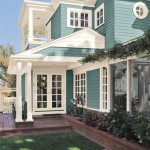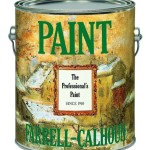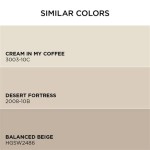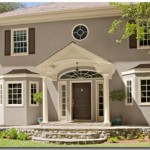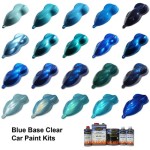Best Dark Blue Paint Colors For Your Home Exterior
Selecting the right paint color for a home's exterior is a crucial decision that significantly impacts curb appeal and overall property value. Dark blue hues, in particular, offer a sophisticated and timeless aesthetic, but navigating the myriad of available shades can be challenging. This article explores some of the best dark blue paint colors for home exteriors, providing insights into their characteristics, undertones, and ideal applications to aid in making an informed choice.
Dark blue paint colors possess the ability to create a sense of depth and drama, transforming a house into a striking visual statement. These colors range from deep navy shades to near-black blues, each offering a unique character. Before committing to a specific color, it is essential to consider factors such as the architectural style of the home, the surrounding landscape, and the desired overall aesthetic. A thorough evaluation of these elements will ensure that the chosen dark blue paint color complements and enhances the existing features of the property.
Furthermore, the specific undertones within each dark blue paint color can influence how it appears in different lighting conditions. Some blues may lean towards a warmer, more inviting feel due to hints of gray or green, while others remain cool and crisp. Understanding these nuances is critical to achieving the desired effect. Sample painting a small area of the home exterior and observing it at different times of day is highly recommended to accurately assess how the color will appear in varying light.
Understanding Undertones in Dark Blue Paints
The complexity of dark blue paint colors lies in their undertones. These subtle hues, often not immediately apparent, profoundly impact how the color is perceived. Common undertones in dark blue paints include gray, green, purple, and black. A blue paint with gray undertones will appear more muted and sophisticated, creating a calming and understated look. Green undertones can impart a more natural and organic feel, blending well with lush landscapes. Purple undertones may add a touch of elegance and richness, while black undertones create a dramatic and almost gothic effect.
Identifying these undertones requires careful observation, ideally under natural light. Comparing paint swatches against a white backdrop can help reveal the subtle shifts in color. Furthermore, consider the existing colors on the home's exterior, such as the roof, trim, and landscaping elements. The chosen dark blue paint should harmonize with these existing colors, creating a cohesive and visually appealing palette. For example, a house with a warm-toned brick facade may benefit from a dark blue paint with warmer, gray or green undertones to avoid clashing.
It's also important to note that the perceived undertones can change depending on the surrounding environment. A dark blue paint that appears neutral indoors may reveal its green undertones when exposed to bright sunlight. Therefore, testing paint samples outdoors is essential to accurately assess the color's true character.
Popular Dark Blue Paint Colors for Home Exteriors
Several renowned paint manufacturers offer a range of dark blue shades that are particularly well-suited for home exteriors. These colors have gained popularity due to their versatility, durability, and ability to create a striking visual impact. Some of the most highly-regarded dark blue paint colors include:
- Sherwin-Williams Naval (SW 6244): A deep, classic navy blue with minimal undertones, making it a versatile choice for various architectural styles. It exudes a sense of sophistication and timelessness.
- Benjamin Moore Hale Navy (HC-154): Another popular navy blue, Hale Navy is slightly softer and more muted than Naval, with subtle gray undertones that give it a sophisticated and calming feel.
- Behr Midnight Blue (BL-W12): A rich, saturated dark blue with a hint of purple, Midnight Blue adds a touch of drama and elegance to any home exterior.
- Sherwin-Williams Gale Force (SW 7605): This darker, almost charcoal blue offers a more contemporary alternative to traditional navy. It's a versatile choice that complements both modern and traditional homes.
- Benjamin Moore Gentleman's Gray (2062-20): While technically classified as a gray, Gentleman's Gray is a deep, complex color that reads as a dark blue in many lighting conditions. It has subtle green undertones that give it a sophisticated and calming feel.
These paint colors each offer a unique character and are suitable for different architectural styles and personal preferences. When selecting a specific shade, it's crucial to consider the overall aesthetic you wish to achieve and how the color will interact with the existing features of your home and its surroundings.
Consider the house’s architectural style when choosing a color. A coastal style home may benefit from a brighter, more vibrant navy, while a Victorian home may look stunning in a deeper, more muted shade with purple undertones. A modern home might benefit from a near-black blue that creates a sleek and contemporary look.
Application and Considerations for Dark Blue Exterior Paint
The successful application of dark blue paint to a home exterior requires careful planning and execution. Proper surface preparation is paramount to ensuring a smooth and long-lasting finish. This includes thoroughly cleaning the exterior surfaces, removing any loose paint or debris, and priming the area before applying the paint. Using a high-quality exterior primer specifically designed for the chosen paint type is crucial for adhesion and color uniformity.
The choice of paint finish also plays a significant role in the overall appearance and durability of the exterior. A satin or eggshell finish is generally recommended for home exteriors, as it provides a subtle sheen that is resistant to dirt and mildew. Flat finishes, while offering a matte appearance, can be more prone to staining and fading. Gloss finishes, while highly durable, can be too reflective and may highlight imperfections in the surface.
When working with dark blue paint colors, it's essential to apply multiple thin coats rather than one thick coat. This approach allows for proper drying and prevents drips and sagging. Pay particular attention to edges and corners, ensuring that the paint is applied evenly and consistently. It is also recommended to paint during favorable weather conditions, avoiding extreme temperatures or humidity, which can affect the paint's drying time and adhesion.
Beyond the practical aspects of application, consider the long-term maintenance of the painted surface. Dark colors tend to absorb more heat, which can potentially lead to faster fading or cracking over time. Selecting a high-quality paint with UV-resistant pigments is essential to minimize these effects. Regular cleaning and maintenance, such as power washing and touch-up painting, can help to extend the lifespan of the paint and preserve its original beauty.
Also, consider the impact of reflected light on the paint color selection. Dark blue paints, particularly those with glossy finishes, can reflect light in ways that alter their perceived color. Observe sample patches of the paint at different times of the day to see how light affects the shades.
Landscaping can also play a significant role in complementing a dark blue exterior. Green shrubbery and colorful flowers can create a striking contrast against the dark backdrop, enhancing the overall curb appeal of the home. Consider incorporating landscaping elements that complement the chosen dark blue paint color, creating a harmonious and visually appealing exterior.
In addition to the main body of the house, consider the trim colors. White trim provides a classic and crisp contrast against dark blue, while other colors such as cream, gray, or even a lighter shade of blue can create a more subtle and sophisticated look. Evaluating different trim color options can help to refine the overall aesthetic and ensure that the house exterior is cohesive and visually appealing.
Finally, remember to adhere to any homeowner association (HOA) guidelines or local regulations regarding exterior paint colors. Some HOAs have restrictions on the types of colors that can be used, and it's important to ensure compliance before commencing any painting project. This will help to avoid potential fines or disputes in the future.

The Best Exterior Blue Paint Colors And Palettes

9 Best Blue Exterior Paint Colors Palettes The Color Concierge

Best Blue Paint Colors For Your Exterior Paintzen

Best Blue Paint Colors

12 Blue Exterior House Colors We Love Brick Batten

9 Best Exterior Blue Paint Colors And Palettes

9 Best Blue Exterior Paint Colors Palettes The Color Concierge

Our Review Of Sherwin Williams Naval Brick Batten

Benjamin Moore Hale Navy The Best Blue Paint Color

Dark Matter 10 Design Ideas To Steal From Houses With Dramatic Facades Gardenista
Related Posts

